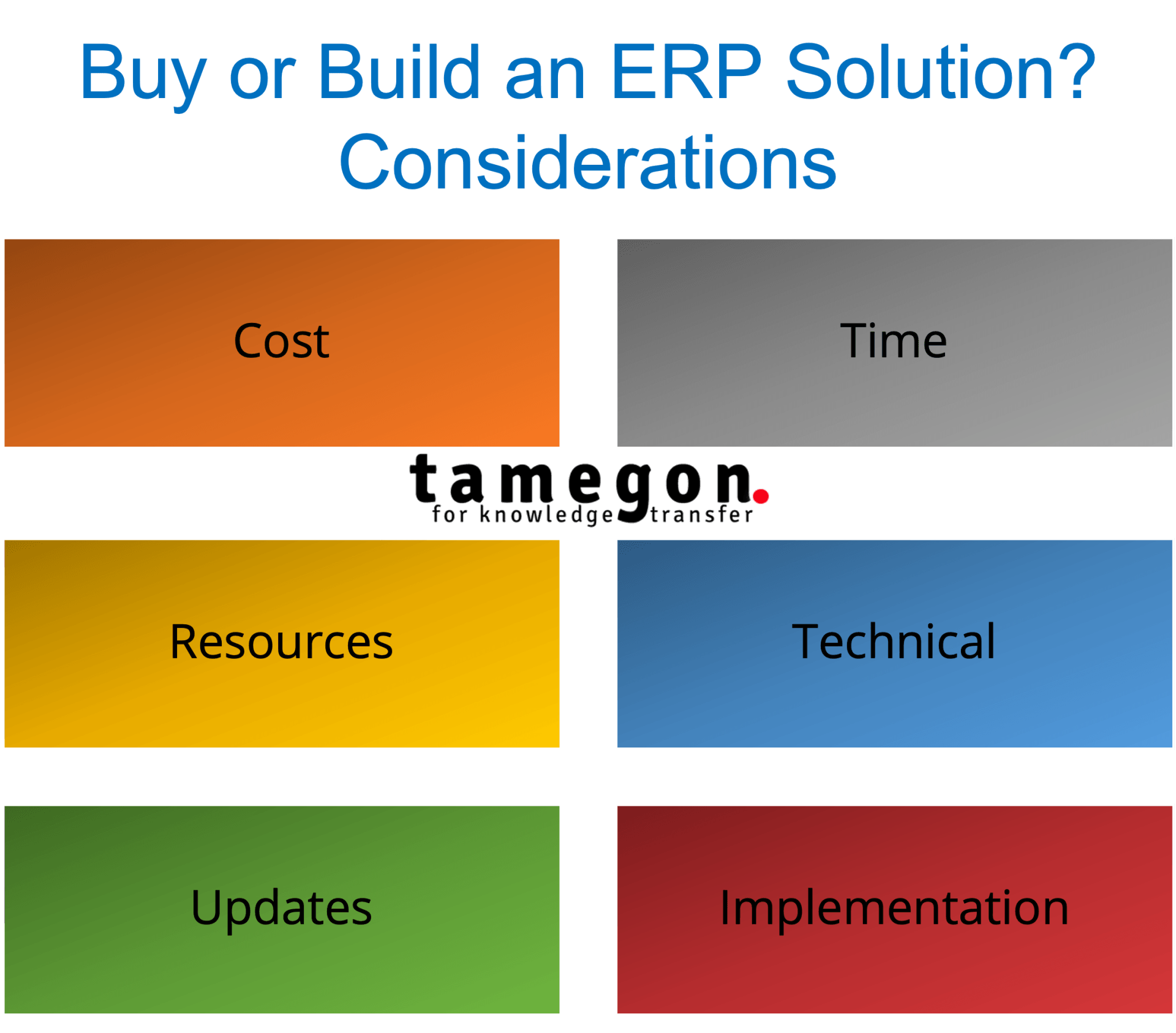
Build or buy an ERP system? - The case for Higher Education Institutions (HEIs)
Dr Costas Chryssou
June 9, 2022
tamegon Innovation and Growth Advisory Firm
Enterprise Resource Planning (ERP) software solutions provide to organisations of any size, sector or industry enhanced operational efficiencies, better business reporting capabilities, as well as improved customer service and supply chain management. In addition, the use of ERP solutions provide the opportunity to reduce operating costs and boost data and business continuity capabilities for any organisation, when cloud applications are used. Research suggests that ERP implementation led to process improvements for 95% of organisations while the top three benefits captured from such implementation were reduced process time, increased collaboration and a centralised data system leading to "one truth" [1].
Although the above benefits also apply to HEIs, their operational requirements are quite different from other types of organisations. For example, HEIs, due to their complexity of purpose, tend to have fragmented internal structures, experience challenges in measuring strategic outputs and outcomes and while they have a high degree of autonomy in some cases, in other cases are being under government dependence, mainly in terms of funding and sometimes regulatory compliance. HEIs find themselves constantly under pressure to deliver high quality education satisfying ever increasing expectations from their stakeholders while at the same time face considerable funding cuts. As a result, adoption of information technology that can improve the operational and organisational performance and reduce costs is perceived by all HEIs as necessary investment to remaining competitive in a global education market.
Many HEIs that are considering investing scarce resources in their digital transformation journey find often themselves pondering the usual"buy or build" management question - the dilemma of whether they should develop their own, in-house ERP software solution that meets their exact needs and match their internal processes or purchase a standard solution from one of the numerous vendors in the market that specialise in the HEI market.
My recent interactions with a number of private HEIs, reminded me that although every university may be different in terms of needs, target markets (local and international), educational programs, and access to funding, the challenges that are trying to address through an ERP solution remain very much the same,
...they all strive to have an efficient and effective means of interacting with and supporting their students' educational pathways prior to admission, during their studies, and after their graduation...
HEIs are in some sense "unique" organisations and their needs from an ERP solution go beyond the typical sales and marketing, supply chain management, HR and finance that any other business has. They include, among other tailored functions, student information systems that map, follow, support, and assist students during their educational journey. In this article, I thought to capture and outline some of the pros and cons of buying a standard ERP software solution for an HEI and compare them to the pros and cons of building an in-house one. Specifically, I wanted to consider the questions:
- Does it make sense for an HEI to build an in-house ERP solution?
- Are there any financial benefits to building rather than buying an ERP solution?
- How are considerations regarding future system updates, emerging needs as the organisation grows and student preferences change, influence the choice between an in-house and a purchased solution?

Considerations for buying or building an ERP solution
- Time - Sometimes urgent implementation of a software solution is paramount. This is particularly the case if an HEI has identified shortcomings in its operations resulting in high costs and in delays responding to student enquiries and their educational support which are translated in loss of income. With several ERP solutions available from ones that cater for 50,000 to 100,000 students and beyond, to ones that target HEIs with up to 10,000 students or below, HEIs have the opportunity to identify solutions that meet their specific operational requirements and documented needs and implement them fast. In contrast, by building their own, in-house ERP system, HEIs will not have the opportunity to test the system until it is completed with subsequent modifications and improvements most likely going to considerably lengthen the time needed to perfect it, implement it and adopt it.
- Resources - Before an HEI even considers developing an in-house ERP solution it needs to evaluate whether it has access to experienced software developers and other experts who will be in a position to also in the long run maintain, support, upgrade and continue developing the solution while student preferences, technologies and the organisation itself changes. Keeping, maintaining and supporting such a team of developers does not come cheap for any organisation with the additional risk of key resources leaving the organisation taking with them crucial knowledge and experience. On the other hand, if an HEI chooses to implement a third-party software solution, the above risks and costs are minimised, but of course any modifications needed to the third-party solution will come at a significant cost.
- Technical - Vendors that operate in the HEI market will most probably offer advanced functionality compared to a potential in-house ERP solution. Vendors can also support the process re-engineering efforts of the HEIs administration team and provide advice on best-in-class procedures and processes that will make interactions with learners faster and more effective - a key differentiating point for any HEI that operates in the global educational market. Thus, ERP implementation can bring positive and significant change to both established and new HEIs and improve the way the student administration works, interacts and supports students in their educational pathways. However, an in-house solution will potentially offer more flexibility to meet the HEI's specific requirements as the organisation scales up and changes, and new functions and features can be added if and when are needed. In addition, when it comes to integration with other solutions, an in-house ERP will most probably offer advanced integration capabilities compared to a third-party software which will have a limited choice of available API integrations.
- Cost - The cost of developing, implementing and maintaining an in-house ERP solution will most probably be considerably higher than the overall cost of buying third-party software. These increased costs will be linked to software experts resources with the additional risks of potential loss of a key developer resource, for example, especially when problems occur and support is required. In contrast, purchasing a third-party solution will offer peace of mind that the solution will be maintained and resource will be available when it is needed. However, what could be adding to the cost of a third-party solution is customisation. Thus, an ERP solution will need to be chosen that satisfies most of the HEI's requirements and that the need for customisation is kept to a minimum.
- Updates - Vendors, being experts in this field, they will keep up with the latest trends, they will be responsive introducing new technologies and ways of doing things in order for them to remain competitive in their market. Therefore, an HEI can also take advantage of the offer of a constantly updated software solution to pass the benefits onto their students and remain competitive themselves. The choice of a solution based on the cloud further enhances these benefits making updates fast and efficient with minimal disruption. In contrast, an in-house solution will be more difficult to be maintained in the long run since considerable resource and expertise will be needed on a continuing basis, to embed the ever changing new technologies and to most importantly satisfy students' preferences which may result in the loss of HEI's competitive edge.
- Implementation - An advantage of purchasing a solution from a vendor is that the HEI can actually demo the overall solution from the start, understand whether it meets its needs, assess its usability and interface, receive feedback from the student administration team and students, and thus make an informed decision before purchasing it. In contrast, the in-house system is not ready from the outset and can only be fully tested once it has been developed. Any modifications and improvements will most probably delay the implementation phase. By purchasing an ERP system, HEIs can also access and capitalise on the knowledge and experience that vendors have gained from many years of developing the whole system and use their insights on how the different modules are interconnected. HEIs can further de-risk their purchasing process by receiving reviews from other clients and that way can assess also the vendor's performance in supporting, maintaining, and developing the system after implementation.
Of course, every HEI and situation are unique and specific advice should consider all of the above points. In general, developing an in-house ERP solution will demand from the HEI a lot of resources in terms of time, money and expertise and the decision to opt for such project should carefully consider whether the HEI is up to the considerable challenge and understands the specific benefits it is trying to gain. Outsourcing the ERP solution to a competent vendor, will certainly allow the HEI to focus its attention, resources and efforts to its educational mission and vision serving best its student community.
But, how does one choose a competent ERP vendor?

Costas Chryssou
MBA, PhD
Founder and Managing Director
Sign up for our
articles
Sign up to our newsletter
Thank you for signing up to receive our articles.
Please try again later










